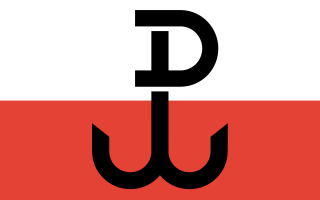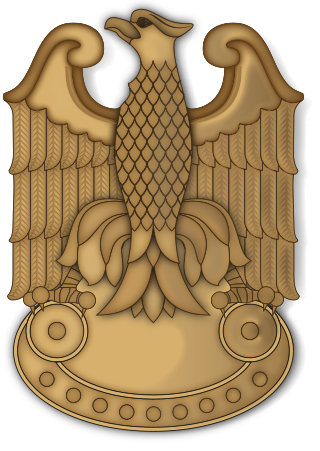
The Home Army was the dominant resistance movement in German-occupied Poland during World War II. The Home Army was formed in February 1942 from the earlier Związek Walki Zbrojnej established in the aftermath of the German and Soviet invasions in September 1939. Over the next two years, the Home Army absorbed most of the other Polish partisans and underground forces. Its allegiance was to the Polish government-in-exile in London, and it constituted the armed wing of what came to be known as the Polish Underground State. Estimates of the Home Army's 1944 strength range between 200,000 and 600,000. The latter number made the Home Army not only Poland's largest underground resistance movement but, along with Soviet and Yugoslav partisans, one of Europe's largest World War II underground movements.

Generał Tadeusz Komorowski, better known by the name Bór-Komorowski was a Polish military leader. He was appointed commander in chief a day before the capitulation of the Warsaw Uprising and following World War II, 32nd Prime Minister of Poland, 3rd Polish government-in-exile in London.

Stefan Paweł Rowecki was a Polish general, journalist and the leader of the Armia Krajowa. He was murdered by the Gestapo in prison on the personal order of Heinrich Himmler.

The Polish Underground State was a single political and military entity formed by the union of resistance organizations in occupied Poland that were loyal to the Government of the Republic of Poland in exile in London. The first elements of the Underground State were established in the final days of the German and Soviet invasion of Poland, in late September 1939. The Underground State was perceived by supporters as a legal continuation of the pre-war Republic of Poland that waged an armed struggle against the country's occupying powers: Nazi Germany and the Soviet Union. The Underground State encompassed not only military resistance, one of the largest in the world, but also civilian structures, such as justice, education, culture and social services.

The kotwica was an emblem of the Polish Underground State and Armia Krajowa used during World War II. It was created in 1942 by members of the Wawer minor sabotage unit within the AK, as an easily usable emblem for the struggle to regain the country's independence. The initial meaning of the initialism PW was "pomścimy Wawer", in reference to the 1939 Wawer massacre, which was considered to be one of the first large scale massacres of Polish civilians by German troops in occupied Poland.

People's Army was a communist Soviet-backed partisan force set up by the communist Polish Workers' Party (PPR) during World War II. It was created on the order of the Polish State National Council on 1 January 1944. Its aims were to fight against Nazi Germany in occupied Poland, support the Soviet Red Army against the German forces and aid in the creation of a pro-Soviet communist government in Poland.

Gwardia Ludowa or GL was a communist underground armed organization created by the communist Polish Workers' Party in German-occupied Poland, with sponsorship from the Soviet Union. Formed in early 1942, within a short time Gwardia Ludowa became the largest clandestine fighting force on Polish soil which refused to join the structures of the Polish Underground State loyal to the London-based government-in-exile. In the January 1 of 1944 GL was incorporated into the communist Armia Ludowa.

The Union of Armed Struggle, also translated as the Union for Armed Struggle, Association of Armed Struggle, and Association for Armed Struggle, was an underground army formed in Poland following its invasion in September 1939 by Germany and the Soviet Union that opened World War II. It existed from 13 November 1939 until 14 February 1942, when it was renamed into Home Army.
During World War II, resistance movements operated in German-occupied Europe by a variety of means, ranging from non-cooperation to propaganda, hiding crashed pilots and even to outright warfare and the recapturing of towns. In many countries, resistance movements were sometimes also referred to as The Underground.

Janusz Bokszczanin was a colonel of the Polish Army and one of the first Polish commanders of the motorized troops in the reborn Second Polish Republic. During World War II he joined the ZWZ resistance organization and later the Home Army. Until 1943 he served as chief of department of rapid response within its headquarters. In 1944, prior to the anti-Fascist Operation Tempest, he became the chief of operations, and deputy chief of staff of the entire Home Army (AK).

In Poland, the resistance movement during World War II was led by the Home Army. The Polish resistance is notable among others for disrupting German supply lines to the Eastern Front, and providing intelligence reports to the British intelligence agencies. It was a part of the Polish Underground State.

Aleksander Krzyżanowskinom de guerre "Wilk" was an artillery colonel of the Polish Army, officer of the Service for Poland's Victory, Union of Armed Struggle, commander of the Vilnius District of the Home Army, political prisoner of the Stalinist period. In 1994 he was posthumously promoted to the rank of brigade general.

Henryk Iwański (1902-1978), nom de guerre Bystry, was a member of the Polish resistance during World War II. He is known for leading one of the most daring actions of the Armia Krajowa in support of the Warsaw Ghetto Uprising, however later research cast doubts on the veracity of his claims. For his assistance to the Polish Jews Iwański was bestowed the title of the Righteous Among the Nations by Yad Vashem in Jerusalem in 1964.

Stalag VIII-F was a German prisoner-of-war camp for Soviet Red Army and Polish Home Army prisoners during World War II. It was located at the northern end of a Germany Army training area at Lamsdorf, Silesia, just to the north of Stalag VIII-B.

The Zamość uprising comprised World War II partisan operations, 1942–1944, by the Polish resistance against Germany's Generalplan-Ost forced expulsion of Poles from the Zamość region (Zamojszczyzna) and the region's colonization by German settlers.

The Home Army Museum in Kraków was created in Kraków, Poland in 2000, to commemorate the struggle for independence by the underground Polish Secret State and its military arm Armia Krajowa, the largest resistance movement in occupied Europe during World War II. The museum is named after general Emil August Fieldorf "Nil". It is the only such institution in Poland promoting knowledge about the Polish Underground State and its armed forces during World War II. The idea behind the Home Army Museum is to provide a holistic picture of the Polish underground, its spiritual origins and the shape of patriotic heritage to the present day.

Adolf Pilch was a Polish resistance fighter during World War II. He became part of the Polish special forces (cichociemni) trained in the United Kingdom, and was parachuted into occupied Poland on 17 February 1943. There, as a member of the Armia Krajowa Polish resistance, he organized a cavalry partisan unit in the Nowogródek area, and broke through to the Kampinos forest near Warsaw, taking control of this area. At its height of operations his unit consisted of up to 1000 men. Between 3 June 1943 and 17 January 1945 his partisans fought in 235 battles.

Mirosław "Stanko" Iringh - was a Polish-Slovak lieutenant and a commander of a Slovakian unit - Platoon 535, serving under the command of the Polish Home Army (AK), part of the 1st Company of the Battalion "Tur", "Kryska" Group, Mokotow region - which took part in the Warsaw Uprising, in particular in the heavy fighting in Czerniaków and in Praga.

Ryszard Feliks Piotrowski, born in Warsaw, was a Major in the Polish Armed Forces and a member of the Polish resistance / Home Army. He fought in the "Sowinski" Battalion, "Waligora" Grouping, under his wartime code name Piorun.

The Blizna V-2 missile launch site was the site of a World War II German V-2 missile firing range. Today there is a small museum located in the Park Historyczny Blizna in Blizna, Poland. After the RAF strategic bombing of the V-2 rocket launch site in Peenemünde, Germany, in August 1943, some of the test and launch facilities were relocated to Blizna in November 1943. The first of 139 V-2 launches was carried out from the Blizna launch site on 5 November 1943.
















